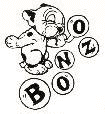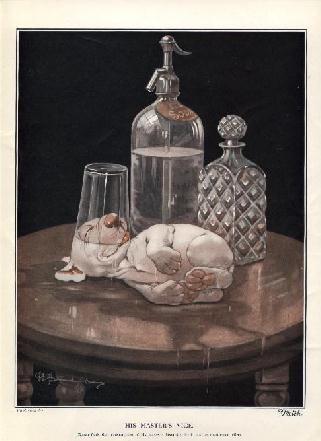 |
 |
 |
 |
 |
 |
|
|
"You know my methods, my dear
Watson," remarked Sherlock Holmes to that rather dull
doctor on countless occasions, and, thanks to Sir Arthur
Conan Doyle, "my dear Watsonís" knowledge is shared by the
world at large. My method - which I have been asked to write about, has, so far, remained a secret for the reason that I am not a great detective, but only an artist on the sleuth trail to discover - not criminals, but humour. I am of the opinion - shared, I am sure, by other humorists of the pencil - that my job is the harder of the two. And it is never ending! No sooner is one drawing finished than I have to think of the next. But where is the idea? A boy at school trying to answer a question looks at the ceiling. My eyes fall on a sheet of blank paper. It is rather a mesmeric sort of business - like crystal gazing! Just as in the crystal, forms appear if you stare long enough, so on that piece of white paper ideas for humorous incidents begin to take shape. Something is evolved. Ideas begin to course through the brain, but at the moment they wonít sort themselves out. As a jumble they are excellent in the bulk, but when sifted they are not worth a row of brass tacks! That is a dreadful moment in an artistís life which constantly occurs. You wonder whether the mine of humour is worked out or whether you are! But then you console yourself with the reflection that - except for one or two inspired moments - this sort of thing has been going on for twenty years or so. There is, alas, no short cut to catch humorous ideas. Well, here I am still in front of a blank sheet of paper and an idea may be still far to seek by luncheon time. But a drawing has to be provided on the following day! Tea may claim my attention, and yet that elusive idea has not been captured. But that does not alter the fact that Editorís wonít wait! Suddenly I get an idea, but on reflection I remember that though excellent in itself, it is not the picture I want at the moment. Let me make my meaning clearer by saying that a funny incident connected with snow would be out of place in a midsummer issue of a paper. And then, at long last, out of all this welter I think of something which makes me smile, and if an idea can do that I am convinced it must be worth carrying out. It takes a lot to make a humorist smile. So now you know why humorous artists often wear a worried look! But not at the moment of triumph! With a sigh of relief I get busy on that piece of blank paper, and what follows is, by comparison, easy. I know the point to which I am leading. All I have to do is to "place" the idea - to squeeze out all the humour that there is in the situation - and that is where training and experience count enormously. A beginner often has humorous ideas but fails at depicting them in pictorial form. Once I am satisfied with my idea I aim at simplicity, for this is essential. I start, say, on a pencil sketch of my prize dog, Bonzo. With him the great point to aim at is the wide range of expression which he can assume and the quaint actions of his body. But all must be simply indicated. The pencil sketch, or sketches, complete, further work on the drawing depends upon the process of reproduction. Bonzo may only appear in black and white as a line drawing, which means finishing in pen and ink. If he is to appear in all the glory of colour, the final touches greatly vary, because there is a very great difference in treatment if the reproduction is by three-colour blocks printed on the flat, and colour printing on a high-speed multiple cylinder press. The former process allows for more refinement of treatment and gives one more latitude. In drawings such as these I make a great feature of still life as a background to my energetic Bonzo, who, generally speaking, is far from still! These still life adjuncts do not satisfy me unless they are convincing and completely in key with the atmosphere of the drawing. I am speaking now more particularly of my drawings of Bonzo, who resembles Topsy in that she wasnít born but growed! Bonzo is but four yearís old and is a late comer in my career. In other work my method, of necessity, varies. For instance, some years ago I used to do theatre sketches, not so much from the point of view of caricature - though this entered into them - but as a satirical commentary on certain scenes enacted. In this sort of work there was no time afforded to wait for inspiration. Impressions had to be secured at once and rough pencil notes made in the darkened auditorium. Thank goodness I gave up theatre work before the plays of Tchickov became the vogue. The masterly inactivity of his characters would have driven me to despair! But though solid thought goes to the making of most of my Bonzo drawings - if I may be permitted to return to his kennel once more - yet it cannot be denied that a sudden inspiration is hard to beat. One of the most popular of all was an inspiration, showing the dog in a somewhat elated condition close to a whisky bottle and a used glass; it was entitled "His Masterís Vice." I can truthfully add that had I been living in America the inspiration for this subject would, in all probability, never have come to me! Just as every famous comedian aspires to playing a tragic role, so, I suppose, does every humorous artist wish that he could devote himself to more "high-brow" work, but when, as in my case, I have spent all my working hours in evolving humorous ideas, and these have struck the public fancy, I find I have not the time for more serious subjects. Nevertheless, I can console myself with the reflection that though art for artís sake cannot be encompassed, yet, in this somewhat dreary world art for laughís sake is not to be despised. And with this apologia pro vita mea I make my exit bow, only adding that so far as Bonzo is concerned I do not draw from the model!  Extract taken from "My Method" |
|
    |
 |